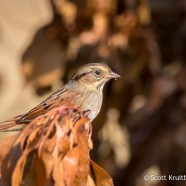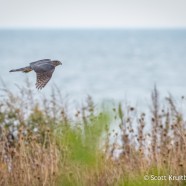Swamp Sparrow
Swamp Sparrows can sometimes be difficult to photograph, but no one told this bird that it was not supposed to be captured this way! Those brush piles can be very productive at this time of year. Make sure to have one or two in your yard this winter, especially if you have bird feeders nearby. They provide cover and a great photographic opportunity.
Read MoreCooper’s Hawk
I have been posting many photos of migrant songbirds lately, and here is one of their predators – the Cooper’s Hawk (Accipiter cooperii). This raptor of the forest is an extremely agile and talented flier, able to navigate through thick woodlands in pursuit of prey. You may recognize them from your yard as they are frequent bird feeder guests, targeting hungry passerines. They seem to be less adept at capturing prey in open areas like this one, unable to fully utilize their maneuverability and relative speed as they do in more dense habitat to surprise and outwit songbirds. This...
Read MoreDark-eyed Junco
It’s that time again! One of everyone’s backyard favorites, the Dark-eyed Junco (Junco hyemalis), is on the way south. These cute little birds are returning to yards like yours now if you are not one of the lucky few to have them year-round. Their autumn arrival, along with that of the White-throated Sparrow, is one of the first big signs of fall to me each October. I look forward to spending six months with friends like this. Scott Kruitbosch Conservation & Outreach Coordinator
Read MoreRed-bellied Woodpecker
In our continuing discussion of why the birds are named the way they are, here we see the reason for the name behind the Red-bellied Woodpecker (Melanerpes carolinus). Yes, they have a red head, but not as red as some woodpeckers that go by that name. These birds have pushed north over the last several decades, inhabiting new breeding grounds and in many cases year-round territories. In the last couple of weeks I have noted an influx of Red-bellied Woodpeckers, especially in migratory hot spots, showing how some definitely do move north. We can see that red belly thanks to these views...
Read MoreEastern Towhee Pair
There have been many, many Eastern Towhees (Pipilo erythrophthalmus) moving through in the last few weeks, some likely scratching away at your yard and feeders. Both the black male and brown female shown here, as recently photographed in Jamestown, New York, really do have lovely shades! Drink your tea…towhee! And Happy Mother’s Day to you and all the soon to be mothers like this one out there.
Read More








